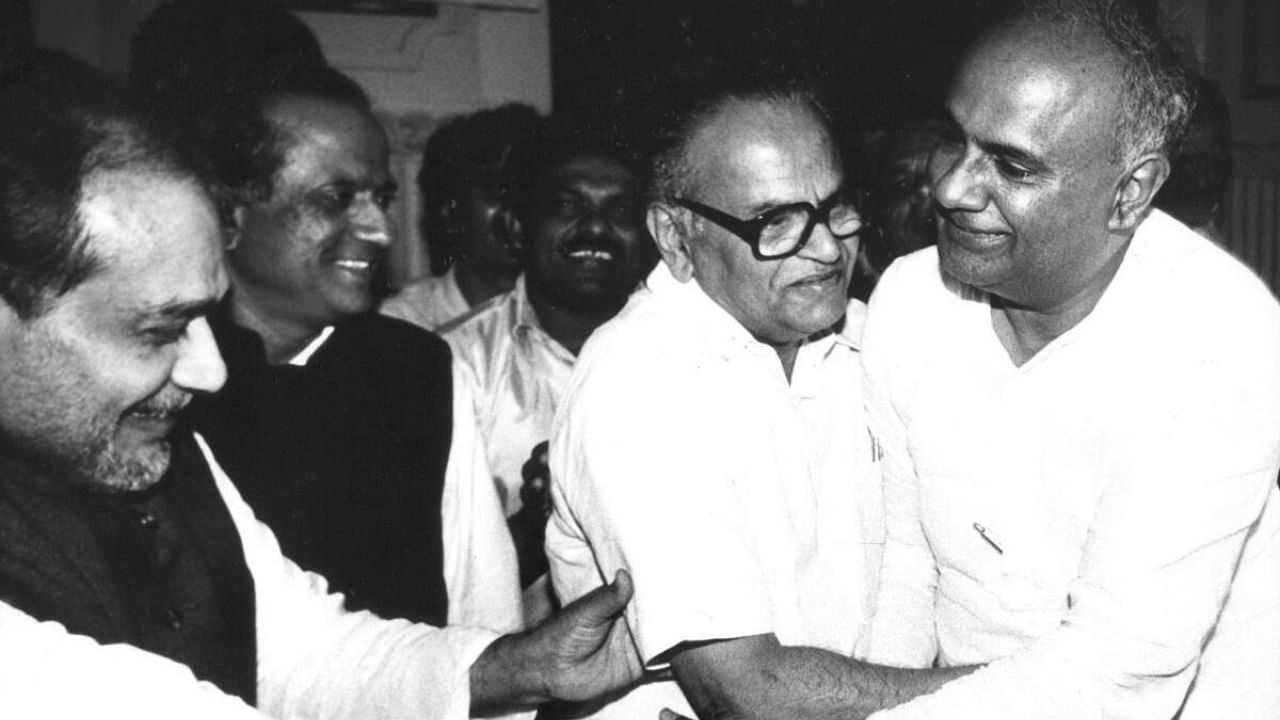
The horse on actor Ajit’s bracelet reminds Amitabh Bachchan of his parents’ killer. Chief minister S R Bommai was engrossed watching this climax of Zanjeer on the VCR after a hectic day placating disgruntled ministerial aspirants. It was April 18, 1989.
This reporter and late Girish Nikam were amazed to see this when ushered into the CMs residence, Balabrooie. Kalyan Rao Molekari, one of 19 MLAs who withdrew support to their own government by submitting a letter to Governor P Venkatasubbaiah, had shown this reporter the acknowledgment from Raj Bhavan before running into a waiting autorickshaw to deliver it to other newspapers.
The very hospitable Bommai got us some tea. When we expressed surprise at his calm, he said problems will be sorted out. We told him his government had lost majority. He did not believe us and asked to be connected to the director general of police who also didn’t know.
When it was finally confirmed, it took him some time to absorb the news. But he remained optimistic that it would be sorted out. He was waiting for his predecessor Ramakrishna Hegde who was away from the city. Some Hegde supporters were among the disgruntled ministerial aspirants. Master strategist H D Deve Gowda had struck through the 19 signatories, bringing down a government that he had built along with the other two.
After sweeping the 1984 Parliamentary elections, Rajiv Gandhi had said that Hegde would be irrelevant after the 1985 state elections. In a remarkable show of maturity, within nine weeks, voters who voted for him at the Centre voted Hegde in the state. With this, they stamped themselves on the world history of democratic elections. But the trio, ably supported by their aides, squabbled to devastate the faith people had reposed in them.
The first trigger to faction formation came when Hegde preferred to be sworn in with B Rachaiah, a respected Scheduled Caste leader, and Abdul Nazir Sab. Hegde was annoyed with Gowda and Bommai for changing the list of candidates after the election committee had finalised it, without informing him. Though they both got cabinet berths, they remained angry at the slight. The bonhomie between Gowda and Hegde, so evident during the first term (1983-85), turned into distrust and bitterness. It rankled Gowda so much that he recalled to this reporter, even a few months ago, the exact date and time he felt humiliated.
The souring of personal relationships was presented as policy differences by Gowda. He publicly criticised populist programmes recommended by a planning council set up by Hegde. He wanted more funds for irrigation and built his base among the farmers. He was appreciated by the Opposition, particularly S Bangarappa. Between Bangarappa, Moily (both Congress), and A K Subbaiah (BJP), they exposed multiple scandals to demolish the “value-based governance” espoused by Hegde. Hegde resigned after he got wired up in a telephone tapping incident.
As Hegde’s popularity kept falling, Gowda slowly expanded his base from Hassan to the Old Mysore region. He became the chief protector of Vokkaliga interests, something that other Vokkaliga CMs had failed to do. He used the removal of the Vokkaligas from OBC list in the state by the Venkataswamy Commission and the protests leading to the blockade of the Bengaluru-Mysore highway for 43 days, to add heft to his political ambitions. The Lingayats, led by Bommai, rode on the back of these protests to get back on the OBC list from which they had been removed by the Havanur Commission.
Redeeming features of governance included A Veeranna reviving small savings to win national awards, while Nazir Sab was acknowledged as the man responsible for decentralising administration. His Zilla Panchayat Act became the precursor to the 73rd Constitutional amendment which provided 30 percent reservation for women in local bodies. Politically, elections to all these bodies proved that the Congress was a force to reckon with, securing 40 percent representation.
The achievements of the first non-Congress government were killed by internecine battles. Finally, Gowda controlled one-third of the party, proving that Hegde was not the undisputed leader of the Janata Party. Defeat was inevitable. The Congress waited patiently for the Janata experiment to fail on its own.
Bommai, however, wrote his name into the Constitutional history of India when the Supreme Court set ground rules on how and where a government’s majority can be tested - certainly not on the whims of a Governor as in 1988. The court order, of course, came five years later.
(The writer is a senior journalist based in Bengaluru)